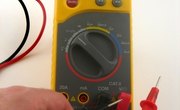Boat owners can save themselves a lot of money if they do much of the yearly maintenance on their crafts themselves. One routine job is removing the boat's batteries for the winter and re-installing them in the spring. Hooking up a boat battery is not a whole lot different than hooking up a car battery. Car owners rarely deal with such issues because auto mechanics are in abundance and not as expensive as marine mechanics. Boat owners also usually want more than one battery. Installing several batteries is easy, however, once you understand the principles behind how the batteries work.
Items you will need
Marine battery (batteries)
Battery strap(s)
Battery switch
Battery isolator
Hook Up a Single Marine Battery
Buy a marine battery, not an automobile battery. Manufacturers make marine batteries to withstand the pounding from waves, constant shifting and bigger drains than car batteries. A car battery will work in a boat, but will be very short lived.
Strap the battery in tight with a heavy-duty battery strap so boat movement does not toss it around in the engine compartment.
Buy the appropriate size battery wires if you need to replace existing wires, or create additional battery ports. Battery wires are the largest wires you will have on your boat. They provide the power to the circuit breaker and the engine. Typical battery wire sizes for modern boats are from 2 gauge to 6 gauge. Consult the manufacturer of your boat to determine the proper size required for electrical installations.
Hook the neutral (black) wire to the neutral (black) port first. This prevents a spark when you hook up the positive wire that could cause an explosion.
Hook Up Two or More Marine Batteries
Set an additional battery in position next to the existing "house" battery that runs everything but your engine. Attach it to the battery compartment with a heavy-duty battery strap.
Attach the existing house battery to the new addition by connecting neutral (black) port to positive (red) port. This creates a series to provide additional power. A series does not give longer battery life, but lets you plug in more appliances and other electrical equipment.
Install a second "house" battery in a parallel union by attaching the first battery's neutral (black) port to the second battery's neutral (black) port and the first battery's positive (red) port to the second battery's positive (red) port. This will give you longer battery life, but not more power than the original battery.
Warnings
- Always connect the neutral wires first to prevent shock or explosion.
Tips
- Use a single marine battery to start your engine and provide extra power for a few small appliances such as a radio. Install a second marine battery for additional power to appliances, lights, navigational instruments or other features that allow you to stay out on the water longer.
- Install a battery switch so that you can keep one battery charged at all times for starting the boat while you drain the battery for entertainment or navigational purposes.
- Install a battery isolator to prevent accidental draining of your starter battery.
- Carry a portable battery charger as an extra prevention against being stranded.
References
Tips
- Use a single marine battery to start your engine and provide extra power for a few small appliances such as a radio. Install a second marine battery for additional power to appliances, lights, navigational instruments or other features that allow you to stay out on the water longer.
- Install a battery switch so that you can keep one battery charged at all times for starting the boat while you drain the battery for entertainment or navigational purposes.
- Install a battery isolator to prevent accidental draining of your starter battery.
- Carry a portable battery charger as an extra prevention against being stranded.
Warnings
- Always connect the neutral wires first to prevent shock or explosion.
Writer Bio
Tami Parrington is the author of five novels along with being a successful SEO and content writer for the past three years. Parrington's journalism experience includes writing for eHow on medical, health and home-related topics as well as writing articles about the types of animals she has raised for years.



